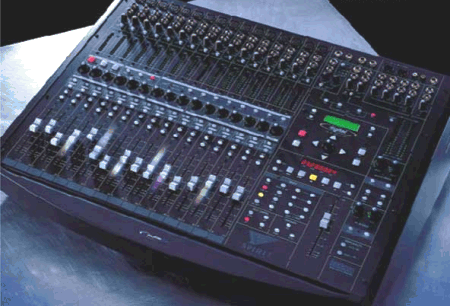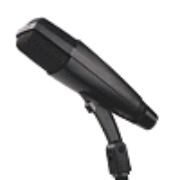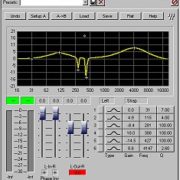PLEASE NOTE: This article has been archived. It first appeared on ProRec.com in May 1999, contributed by then Contributing Editor Bob Lichty. We will not be making any updates to the article. Please visit the home page for our latest content. Thank you!
Despite my glowing, youthful appearance, I harbor an ever increasing affinity for what can only be deemed, “old-school ways.”
You see, because of the way I tend to work on projects (lay down click tracks and sequences in one place, do tracking at one place, overdubs at a few more places, mix elsewhere), I’m still one of those holdouts with some ADATs and that ancient beast, a mixing console. Yes, while many of my comrades are marching into battle armed with “SCSIs, plug-ins, HUIs, GUIs and LOUIEs,” I still love my buttons and knobs and the familiar whir of the tape transport.
So, when the age of the affordable digital console dawned, I was excited. I mean, I may be old school, but I certainly realize the benefits of a good digital console.
The problem is, in these early digital boards, the word “good” just wasn’t easily included in the description. These early desks were, shall we say, “engineering driven.” Some guys in lab coats in the back rooms of Big Audio Conglomerate, Inc. realized they could put all this processing in a small package, have it almost resemble a mixing board, and cast their line out to us gear-freaks waiting with baited-breath. Unfortunately, none of these consoles worked the way us “old schoolers” like them to. No buttons, no knobs, just lots and lots of menus.
So, when I started hearing a small buzz about the Spirit 328 digital console, about how they had thought to make it more geared to those of us who remember sneezing from tape dust, I figured, all right, I’d give it a whirl. And guess what, I’m glad I did.

Let me ask this, am I the only who finds it incredibly cool that I could fit a digital mixing board, 2 ADATs, a pair of monitors and a power amplifier in the back seat of my ’94 Honda Civic? The footprint on the 328 is small, as it is all housed in a 16-channel frame. As is the case with many consoles these days, channels pull “double duty,” so 1-16 are also 17-32. Though I’m all for saving space, I do miss the days of “oohing and ahhing” over the big mixing board with the big knobs.
Setup and Configuration
Anyway, I decided to set up shop in my friend, colleague, and band mate David Butler’s basement. Dave is a design engineer of frightening proportions, currently burying himself in the world of DSP. The thing that’s fun about working with Dave is that he doesn’t have a lot of experience in running a board, so he’s a great guinea pig for products like this. Is it intuitive enough for Dave to get stuff happening on it?
The surprising answer with the 328 is, yes. We unboxed it and promptly put the manual aside, seeing if our intuitions would be enough. The back of the board has all the ins and outs, and we quickly found the ADAT opticals. (The run down of connections is this: (2) ADAT Optical in and out, 2 TDIF in and out, 1 variable output on ADAT Optical, AES in and out, SPDIF in and out, MIDI in and out, Wordclock in and out, SMPTE input, Sony 9 pin for Machine Control (RS-422), and finally, a Cascade Port for connecting two boards together to allow you 32 track recording and 84 inputs at mixdown.) After a quick run through the board we were getting signal, and after another short time, we had mics up and routed to tape. Total set up time for initially getting sounds through and hearing “pretty noises,” about an hour. (Considering I had a guy from Euphonix with me for 2 days one time, and could have used him for 2 weeks, I thought this was pretty darn good.)
There are some funky issues with the routing that should probably be mentioned. When using optical with ADAT, the assignments are such that channel 1 goes to track 1, channel 2 to track 2 and so on. Thus, it can end up like using your direct outs on an analog board. If you lay down a guitar track and want to double it, you can’t simply reassign the channel to another bus, you actually need to physically move the input from one channel to the next. A minor headache, I realize, but still something that set me back a bit. The other thing about routing on this board is that it is not friendly to the true dinosaurs out there that may still have an analog deck at home. There are no direct outs on the console, thus forcing you to use up your inserts to send to tape. This really becomes an issue when you have a microphone up, want to throw some compression on, then send it to tape.
The thing that really sets this board apart from the others is what Spirit calls the E-Strip (Encoder Strip). This is basically a horizontal traditional input module. After selecting a channel, the E-Strip shows all the settings in a pretty conventional layout (other than the fact that it is horizontal). You can grab a knob and set EQs (with a very nice visual display), Aux Sends, etc just like you used to.
And while making sure you hit the right channel button takes some getting used to (“Why am I not hearing any change? Uh-oh!”), there are several layers of undo, making this baby pretty goof-proof.
There is a built-in effects processor on board, compliments of some small company called “Lexicon” that sounds great. The pallet is wide to choose from, covering a slew of halls, chambers, rooms, plus delays, flanges, choruses and a few silly, fun things that every processor should have. There is a limit of two effects being used, so you couldn’t use this alone for a full mix, but certainly for a small demo it makes great sense. There are also some very nice dynamic processors built in (compressors and gates). I really enjoy using dynamic effects with visual displays. It provides an excellent insight to really understand what you are doing to the signal.
Sound and Mixing
The 24 bit converters on the 328 are very clean, and the sound quality is excellent. The mic preamps offer 66 dB of gain range and +28 dBu maximum input level headroom. Dave and I recorded some acoustic guitars and vocals, then Dave did a lot of experimenting with drum machines, electric guitars, bass, vocals, acoustic, etc. How nice that there actually 16 microphone pre-amps on this console. Man, I’m tired of getting a 16 channel board home and finding it has 12 or worse yet, 8 microphone inputs! Of course, the good and bad of a good digital board is it’ll give you what you give it, therefore mics, instruments and rooms become even more crucial than they were before.
There is also metering on every channel on this board (no, the meterbridge isn’t an “accessory”). Metering is peak/hold style, and there are meters for each channel, group, all control room outputs and effects send levels. There is a METER BANK menu that allows you to select between monitoring Mic/Line, Tape and Master levels.
As one would expect with a digital console, the mixdown can be fully automated (EQ, Aux sends, level and mute) via snapshot automation or through MIDI to a separate computer. The snapshots may be assigned a specific time to be recalled via MIDI clock, MTC or SMPTE and up to 100 snapshot locations can be stored. The dynamic automation through MIDI allows full automation from MIDI sequencing packages such as Cakewalk and Cubase. The 100 mm faders are motorized, to help with that “ooh factor”, and they are very quiet. During automation the faders are set up to a 128-step resolution.
Conclusion
So, how did Dave do? I had to jaunt off on a couple training trips while Dave had the board in his house. He only ended up with a couple questions on routing, especially to the effects section. He sent it through the paces, as did I, and we both ended up with the conclusion that for a project studio, this is THE digital console to get.
Spirit’s web site is VERY helpful and is loaded with information on the 328. Downloads of new software can come right from the site, and they have posted many of the FAQs and tech support issues that they have dealt with, thus saving phone time.
Ease-of-use, great sound and some nice features make this board ideal for those with a couple ADATs or any of the DAs from Tascam. (In fact, you can even control your machines right from the console!) With a retail price around $5,000 the price won’t dent your wallet either. If you are looking at combining it with an analog system, or if you have more than (2) MDMs, you might want to think twice. The only other drawback is that the board doesn’t allow one to mix in surround sound, although I understand this is being remedied. For those of us who work in numerous places, and are still stuck with tape-based machines, the Spirit 328 is an ideal console.


